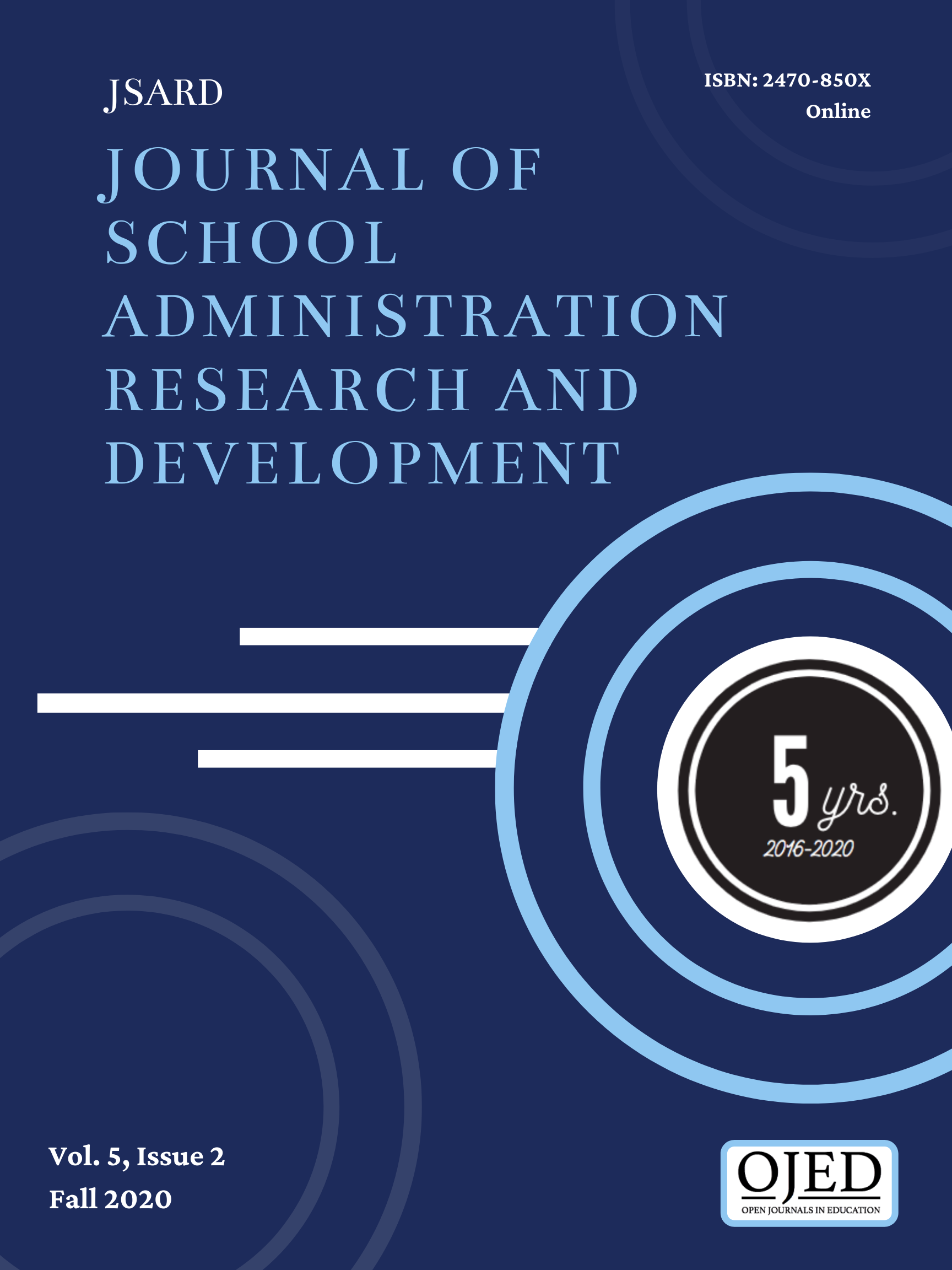Analysis of a School-Based Behavioral Health Program: Exploring the Value of Mental Health Services for Vulnerable Students
DOI:
https://doi.org/10.32674/jsard.v5i2.3156Keywords:
mental health, trauma-informed, schools, adolescents, childrenAbstract
This paper explores the effectiveness of public school-based mental health treatment for K-12 students. Extant clinical data from 2017- 2018 for behavioral health service recipients (n = 874) was used in this analysis. Relationships among clinical diagnosis at discharge, duration in treatment, student participation, and status of mental health improvement were examined. Logistic regression explored associations among variables of interest. Results indicate 74.3% (n = 649) of students were identified by clinicians with improvement in mental health status at discharge. The most prominent mental health diagnoses being treated in the schools were depression, anxiety, and trauma. Students involved in treatment were over 15 times more likely to be categorized as having an improved mental health status; students who lacked participation were 63% less likely to improve. Our results highlight the necessity for school administrators to prioritize and support school-based mental health services. The findings provide school administrators guidance, evidence, and impetus for implementing effective school-based mental health programs.
Downloads
References
American Psychiatric Association. (2013). Diagnostic and statistical manual of mental disorders (5th ed.).
American Psychological Association. (2020). Fact Sheet: Psychologists, school-based health centers, and Medicaid. Public Interest Government Relations Office. American Psychological Association Services. http://www.apa.org/about/gr/pi
Brener, N.D., Demissie, Z., McManus, T., Shanklin, S.L., Queen, B., & Kann, L. (2016). School health profiles 2016: Characteristics of health programs among secondary schools.
Cook, C. R., Frye, M., Slemrod, T., Lyon, A. R., Renshaw, T. L., & Zhang, Y. (2015). An integrated approach to universal prevention: Independent and combined effects of PBIS and SEL on youths’ mental health. School Psychology Quarterly, 30(2), 166-183. https://doi.org:10.1037/spq0000102
Demissie, Z. & Brener, N. (2017). Demographic differences in district-level policies related to school mental health and social services – United States, 2012. Journal of School Health, 87(4), 227-235. https://doi.org:10.1111/josh.12489
Dorado, J., Martinez, M., McArthur, L., Leibovitz, T. (2016). Healthy environments and response to trauma in schools (HEARTS): A whole-school, multi-level, prevention and intervention program for creating trauma-informed, safe and supportive schools. School Mental Health, 8(1), 163-176. https://doi.org:10.1007/s12310-016-9177-0
Eklund, K., Meyer, L., Way, S., & McLean, D. (2017). School psychologists as mental health providers: The impact of staffing ratios and medicaid on service provisions. Psychology in the Schools, 54(3), 279-293. https://doi.org:10.1002/pits.21996
Grassetti, S. N., Williamson, A. A., Herres, J., Kobak, R., Layne, C. M., Kaplow, J. B., & Pynoos, R. S. (2018). Evaluating referral, screening, and assessment procedures for middle school trauma/grief-focused treatment groups. School Psychology Quarterly, 33(1), 10-20. https://doi.org:10.1037/spq0000231
Hoover, S. A., Sapere, H., Lang, J. M., Nadeem, E., Dean, K. L., & Vona, P. (2018). Statewide implementation of an evidence-based trauma intervention in schools. School Psychology Quarterly, 33(1), 44-53. https://doi.org:10.1037/spq0000248
Kang-Yi, C. D., Wolk, C. B., Locke, J., Beidas, R. S., Lareef, I., Pisciella, A. E., Lim, S., Evans, A. C. & Mandell, D. S. (2018). Impact of school-based and out-of-school mental health services on reducing school absence and school suspension among children with psychiatric disorders. Evaluation and program planning, 67, 105–112. Retrieved from https://www.ncbi.nlm.nih.gov/pmc/articles/PMC5835186/pdf/nihms931122.pdf
Kim H. Y. (2015). Statistical notes for clinical researchers: effect size. Restorative dentistry & endodontics, 40(4), 328–331. https://doi.org/10.5395/rde.2015.40.4.328
Lally, P., van Jaarsveld, C. H., Potts, H. W. & Wardle, J. (2010), How are habits formed: Modelling habit formation in the real world. European Journal of Social Psychology, 40, 998-1009. https://doi.org:10.1002/ejsp.674
Langley, A. K., Nadeem, E., Kataoka, S. H., Stein, B. D., & Jaycox, L. H. (2010). Evidence based mental health programs in schools: Barriers and facilitators of successful implementation. Springer, 2(3), 105-113. https://doi.org/10.1007/s12310-010-9038-1
Levine, M. (2015). Children come first? A brief history of children’s mental health services. American Journal of Orthopsychiatry, 85(5), S22-S28. https://doi.org:10.1037/ort0000115
McInerney, M., & McKlindon, A. (2014). Unlocking the door to learning: Trauma-informed classrooms & transformational schools. Education Law Center. https://www.elc- pa.org/wp-content/uploads/2015/06/Trauma-Informed-in-Schools-Classrooms-FINAL- December2014-2.pdf
National Association of School Psychologists. (2016). Creating trauma-sensitive schools: Brief tips & policy recommendations. http://www.nasponline.org
National Center for Education Statistics. (2018) District Directory information. Institute of Educational Sciences. https://nces.ed.gov/ccd/districtsearch/district_detail.asp?ID2=5308250
National Child Traumatic Stress Network. (n.d). Essential Elements. https://www.nctsn.org/trauma-informed-care/trauma-informed-systems/schools/essential-elements
Office of Superintendent of Public Instruction, Washington. (n.d.). Trauma Informed Schools. https://www.k12.wa.us/trauma-informed-schools
Soleimanpour, S., Geierstanger S., & Brindis, C. D. (2017). Adverse childhood experiences and resilience: Addressing the unique needs of adolescents. Academic Pediatrics, 17(7), S108-114. 108114. https://doi.org/10.1016/j.acap.2017.01.008
Schilling, E., Aseltine, R., Gore, S. (2007). Adverse childhood experiences and mental health in young adults: a longitudinal survey. BMC Public Health. 7(30). https://doi.org:10.1186/1471- 2458-7-30
Sterzing, P. R., Fisher, A. J., & Gartner, R. E. (2019). Familial pathways to polyvictimization for sexual and gender minority adolescents: Microaffirming, microaggressing, violent, and adverse families. Psychology of Violence, 9(4), 461-470. https://doi.org:10.1037/vio0000224
Thapar, A., Collishaw, S., Pine, D. S., & Thapar, A. K. (2012). Depression in adolescence. The Lancet, 379 (9820), 1056-1067. https://doi.org:10.1016/S0140-6736(11)60871-4
United States Department of Health and Human Services. (2019). Talk about mental health: For educators. https://www.mentalhealth.gov/talk/educators
United States Department of Justice. (2012). Report of the attorney general's national task force on children exposed to violence. https://www.justice.gov/defendingchildhood/cev-rpt-full.pdf
Walker, T. (2018). Are schools ready to tackle the mental health crisis? National Education Association. http://neatoday.org/2018/09/13/mental-health-in-schools/
Wolk, C. B., Stewart, R. E., Eiraldi, R., Cronholm, P., Salas, E., & Mandell, D. S. (2019). The implementation of a team training intervention for school mental health: Lessons learned. Psychotherapy, 56(1), 83-90. https://doi.org:10.1037/pst0000179
Downloads
Published
Issue
Section
License
All published articles are licensed under a Creative Commons Attribution-NonCommercial-NoDerivs 4.0 Unported License.


.png)
